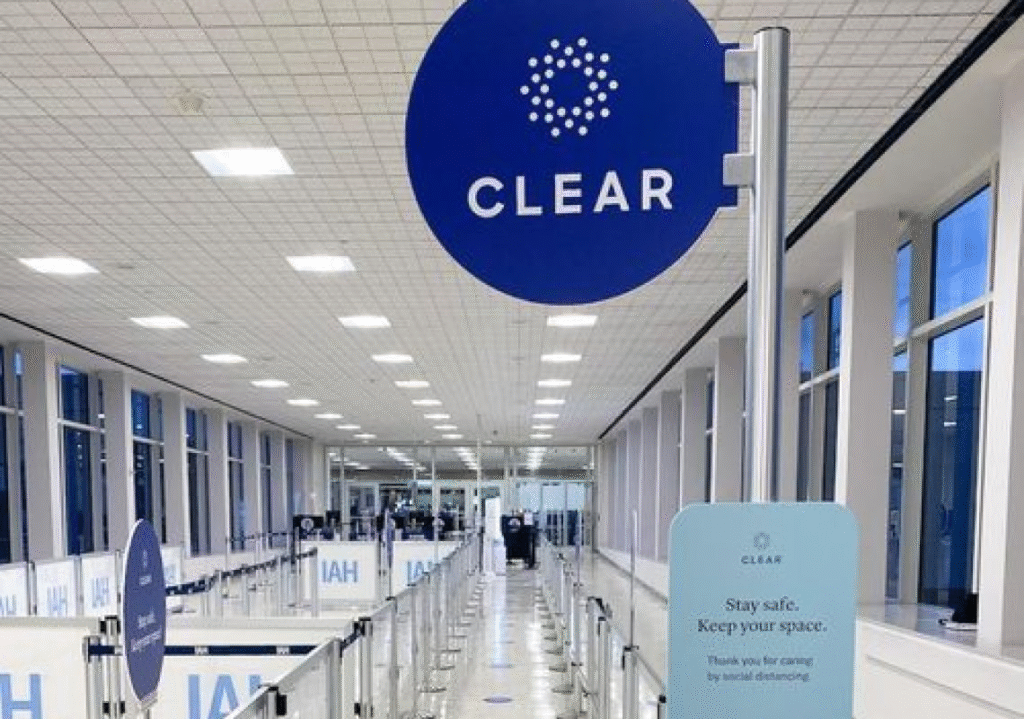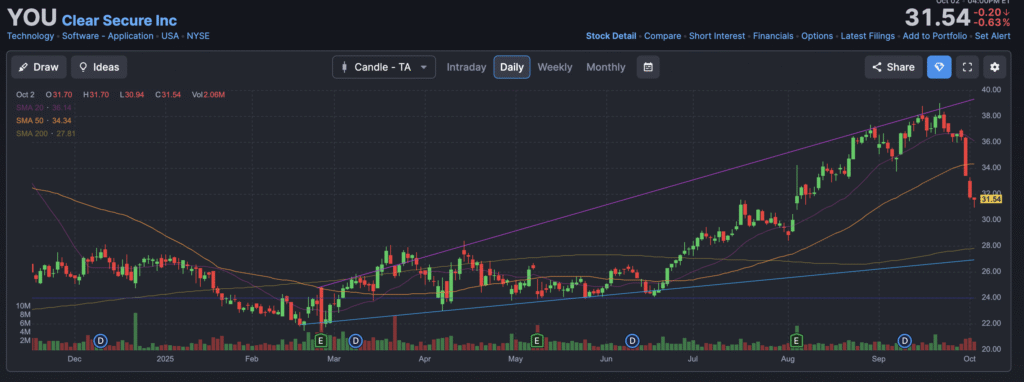Clear Secure, Inc. operates a biometric identity / identity verification platform under the CLEAR brand in the United States. Its services include airport security line access (via paid membership “CLEAR Plus”), virtual queue management (Reserve by CLEAR), identity verification for business partners (CLEAR Verified), and digital identity solutions (e.g. “Sora ID”). The company positions itself in the intersection of security, travel, and identity infrastructure. It monetizes via subscriptions, licensing, and platform agreements with venues (airports, stadiums) and enterprise partners. Over time, it has expanded beyond airports into stadiums, events, and digital identity services. Its mission centers on enabling frictionless identity verification to improve both security and user convenience.

2. Recent Earnings & Guidance
In its most recent reporting (Q2 2025, reported August 5, 2025), Clear Secure posted revenue growth of ~18%, exceeding guidance by roughly 160 basis points. Bookings (new contractual commitments) grew ~13%, ~130 bps above guidance. Active members of CLEAR Plus grew by 7.5% year-over-year to 7.6 million, adding 211,000 net new members (lower than 297,000 additions in Q2 2024). However, EPS declined ~7% year-over-year in that quarter, reflecting margin pressure. The company’s guidance remains cautious given macro and travel uncertainties; analysts note that slowing growth metrics and softer travel trends may temper future performance.
3. History, Founders, Products, Competitors, HQ
Clear Secure traces its origin to Verified Identity Pass, Inc. (original CLEAR), which was founded in 2003 but later shut down and was relaunched in 2012 by Caryn Seidman-Becker alongside Ken Cornick. The name “Clear Secure, Inc.” and the ticker YOU came with its public listing in 2021. Its headquarters are in New York City. Key products include:
- CLEAR Plus: subscription-based service giving users expedited access in airport security lanes and other venues.
- Reserve by CLEAR: virtual queue / appointment-based access to security screening.
- CLEAR Verified / Sora ID / identity platform: business-facing identity verification and KYC / credentialing solutions.
- TSA PreCheck enrollment / renewals and other identity services.
Its principal competitors or adjacent peers include security / identity verification firms, biometric authentication providers, and firms servicing the travel tech / security space (for example, Idemia, CLEAR’s alternative identity platforms, and traditional security infrastructure providers).
4. Market & Industry Trends
Clear operates in the broader identity verification / biometrics / secure identity infrastructure market, overlapping with travel security, stadium/event access, and enterprise identity solutions. Growth in this market is being driven by rising demands for security, regulatory pressures (KYC, digital identity laws), and consumer expectations for seamless, frictionless experiences.
By 2030, the identity verification / digital identity market is projected to grow substantially (CAGR estimates often in high single digits to low double digits depending on segment). (I did not locate a precise 2030 forecast in my quick research). Clear’s opportunity comes from expanding its addressable market — beyond airports into sports venues, event access, healthcare, credentialing, etc. Travel growth (post-pandemic recovery) is another key variable, since its legacy business is tied to airports.
However, the sensitivity to travel volumes is a headwind: if travel demand softens, customers may perceive less value in paying for expedited access. Also, regulatory scrutiny around facial biometrics and privacy may restrain growth or impose compliance costs.
5. Competitor Landscape
On the competitor front, Clear faces competition from:
- Biometric and identity verification players (e.g. Idemia, NEC, IDEMIA, Jumio, Onfido) in the broader identity / authentication space
- Traditional security / access control / badge-based systems which may be entrenched in certain venues or regulatory settings
- Airport / travel security alternatives and enhancements (e.g. TSA PreCheck, mobile credentialing)
- Emerging decentralized identity / self-sovereign identity systems which, if adopted widely, could undercut centralized biometric models
Because Clear combines consumer subscription, venue partnerships, and platform orientation, its competition spans many fronts—not just “other biometric providers.”
6. Unique Differentiation
Clear’s key differentiators include:
- Integrated platform + consumer subscription model: Rather than just selling identity verification to enterprises, it builds a consumer base of paying users (CLEAR Plus) which both validates demand and provides recurring revenue
- Venue partnerships & network effect: Its presence in airports, stadiums, and venues gives it a physical network that can be leveraged for cross-selling identity services
- Proprietary biometric and identity infrastructure: Its tech stack, biometric matching, identity linking, and credential management form a moat (if maintained)
- Hybrid B2C / B2B strategy: The ability to serve both consumers and enterprise / venue partners offers diversification
- First mover & brand awareness in expedited security space: CLEAR has become one of the more recognized names in biometric expedited access, giving it some brand advantage
7. Management Team
Here are a few of the key executives (no pictures):
- Caryn Seidman-Becker – Co-founder & CEO. A long-time leader, she has guided CLEAR through its relaunch, growth, and public listing.
- Ken Cornick – Co-founder & Chief Investment Officer / CFO (in various leadership roles). Co-founder alongside Seidman-Becker, involved in capital strategy and operations.
- [Third key executive could be CTO or COO] – (I did not find a consistently cited third leadership name in my rapid review, though the company has leadership in technology / operations).
These people are central to the vision, execution, and capital allocation decisions of Clear. (Further digging into their bios and track records would yield more on domain expertise, prior successes, etc.)
8. Financial Performance (Last 5 Years)
Over the past 5 years, Clear Secure has shown strong revenue growth, although with volatility in margins and profitability. Pre-2021, as a growth-stage company, it carried higher risk; since going public, more clarity emerges. For example, recent trailing revenues are ~$835.5M, and net income (TTM) ~$176.9M. That implies a net margin of ~21% on recent results. The revenue growth has been robust; analysts note strong growth year-over-year in the recent quarter (~18% as noted above). Over a 5-year span, revenue CAGR is meaningful (though precise CAGR requires detailed historical figures).
Earnings have similarly grown, though margin pressures and expense scaling have caused fluctuations. The balance sheet appears healthy: in commentary, the company has been cited as having “strong financial health with no debt and solid cash flow.” Also, some sell-side skepticism (e.g. Spruce Point) notes risk in margin compression or overvaluation. The company has also engaged in share buybacks and special dividends, returning capital to shareholders.
On the balance sheet, Clear has been described (by external commentary) as having limited leverage (or debt) and generating positive free cash flow, which strengthens its financial flexibility. That gives it room to invest in tech, expand, or weather cyclical downturns.
9. Bull Case for YOU
- Expansion beyond air travel into stadiums, events, healthcare, credentialing could unlock large addressable markets beyond core operations
- Strong recurring revenue base (subscriptions) + network of venue partnerships offers scaling potential and margin leverage
- Increasing regulatory and security demands globally could favor biometric identity solutions, and CLEAR’s brand / infrastructure could benefit
10. Bear Case for YOU
- Heavy dependency on travel volumes: downturns in travel could erode perceived value of CLEAR
- Regulatory or privacy pushback against biometric systems (e.g. facial recognition laws or bans) could impose restrictions or extra cost
- Margin compression or competitive pressure from other identity verification platforms, decentralized identity solutions, or rival biometric providers
The stock is in a stage 4 markdown on the weekly chart and has multiple stop points to reverse at $30 and $28. The near team outlook is to head lower, and if there is a reversal this should be a good move higher. This was a broken cup and handle, so while the setup was good, it is no longer a strong mover to the high side.
